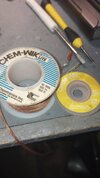I need to order a new roll of braid and I'm not familiar with the different products. I've only made 2 past purchases of Braid in my lifetime: 1 roll worked very good while the other, not (I wanted to type "sucked" but it plainly did not). For me, a small roll Braid lasts years so I want an informed buy. What is the low down on soldering braid product selection?
You are using an out of date browser. It may not display this or other websites correctly.
You should upgrade or use an alternative browser.
You should upgrade or use an alternative browser.
-
You can now help support WorldwideDX when you shop on Amazon at no additional cost to you! Simply follow this Shop on Amazon link first and a portion of any purchase is sent to WorldwideDX to help with site costs.
What is the best Braid to use for removal of solder.
- Thread starter Naysayer
- Start date
Just don't buy the really cheap stuff because it'll do like the braid you say didn't work so well. MG chemicals makes a good one.I need to order a new roll of braid and I'm not familiar with the different products. I've only made 2 past purchases of Braid in my lifetime: 1 roll worked very good while the other, not (I wanted to type "sucked" but it plainly did not). For me, a small roll Braid lasts years so I want an informed buy. What is the low down on soldering braid product selection?
Just a tip.
Flow with fresh leaded solder before and don't be afraid to use some flux, it helps a lot plus will even help the cheap wick do better.
Like above poster, I prefer a sucker but some situations one works better than the other.
I have some old, cheap braid and it only wicks if I rub flux into it. It works great then. Since I got a solder-sucking iron, I rarely use braid except to clean pads.
When it comes to desoldering braid, it's all about how much flux is in the braid, and how old and oxidized the braid has become. Poor quality braid, becomes very usable with the addition of quality flux in liquid form. I've actually been using the braid out of RG-174 coax and adding my own flux.
Like others mentioned, I start with a solder sucker and only resort to the desoldering braid, to free up stuck pins. There are different techniques to using a solder sucker. Some people push the button while the soldering iron is still intact with the connection. That tends to leave more solder in the hole. The other method, is to hold the sucker at an angle right up against the connection as you're heating it.
As soon as you remove the soldering iron try to position the sucker so that you get a seal around the connection and then push the button as quick as possible before the solder cools. That creates a suction right through the hole in the board. Little things like positioning the circuit board vertically so that you are not fighting gravity, also improves results in stubborn cases.
Like others mentioned, I start with a solder sucker and only resort to the desoldering braid, to free up stuck pins. There are different techniques to using a solder sucker. Some people push the button while the soldering iron is still intact with the connection. That tends to leave more solder in the hole. The other method, is to hold the sucker at an angle right up against the connection as you're heating it.
As soon as you remove the soldering iron try to position the sucker so that you get a seal around the connection and then push the button as quick as possible before the solder cools. That creates a suction right through the hole in the board. Little things like positioning the circuit board vertically so that you are not fighting gravity, also improves results in stubborn cases.
All that desoldering braid is, is simply that.... Braid impregnated with solder flux, but yes, the quality of the braid and the flux used to make it are what matters. The tighter the braid, the better it works.
I tend to burn-through Techsspray "Prowick" #4 more than any of the others in the drawer... It's extremely thirsty. Good stuff.
NTE braids are great too, but overpriced for what you get.
ANY braid you end-up with (especially 90% braid stripped from some old coax) can be forced to werk great --- provided you have a bottle of Kester #186 liquid flux. Just saturate the braid with it and let it air dry for best results.
I tend to burn-through Techsspray "Prowick" #4 more than any of the others in the drawer... It's extremely thirsty. Good stuff.
NTE braids are great too, but overpriced for what you get.
ANY braid you end-up with (especially 90% braid stripped from some old coax) can be forced to werk great --- provided you have a bottle of Kester #186 liquid flux. Just saturate the braid with it and let it air dry for best results.
Yeah. I once found a spool of braid that was dark brown from age and even pushing flux into it didn't work well. A few quick pulls of a length of braid, through a piece of folded over 1000 grit sand paper, made it nice and shiny and would wick very good.
Edited, added photo. I have no preference on brand of wick, but the chem-wik works fine.
Edited, added photo. I have no preference on brand of wick, but the chem-wik works fine.
Attachments
I’ve never used one, but saw on YouTube they seem to work well.I have far better luck with a solder sucker. The parts you are desoldering stay much cooler when using a solder sucker instead of braid.
Thirsty wick, that’s what I need thanks. I’ve used coax too on occasion but labor intensive. Seems a solder vacuum is on my shopping list. Thank youAll that desoldering braid is, is simply that.... Braid impregnated with solder flux, but yes, the quality of the braid and the flux used to make it are what matters. The tighter the braid, the better it works.
I tend to burn-through Techsspray "Prowick" #4 more than any of the others in the drawer... It's extremely thirsty. Good stuff.
NTE braids are great too, but overpriced for what you get.
ANY braid you end-up with (especially 90% braid stripped from some old coax) can be forced to werk great --- provided you have a bottle of Kester #186 liquid flux. Just saturate the braid with it and let it air dry for best results.
Last edited:
Glad to be of help.Thirsty wick, that’s what I need thanks. I’ve used coax too on occasion but labor intensive. Seems a solder vacuum is on my shopping list. Thank you
Still, there are de-soldering tools I wish I had, but cannot justify the cost of.
Chem-Wik is the only brand I use now. Used many others over the years and have to say Chem-Wik is the best. Warning is it not cheap! It has doubled in price!
Good stuff, but also high cost like the NTE.. Probably worth it if you use solder wick occasionally because it seems to have a longer 'shelf life' than cheaper brands. Maybe it's the flux they use?Chem-Wik is the only brand I use now. Used many others over the years and have to say Chem-Wik is the best. Warning is it not cheap! It has doubled in price!
A tip when using coax braid as wick. I found that after drawing it into a tight strand, hammering it flat increases capillary action and removes oxides, so I always flatten it and apply flux right before I use it. I haven't done that since getting MG #453 though.
dxChat
- No one is chatting at the moment.


